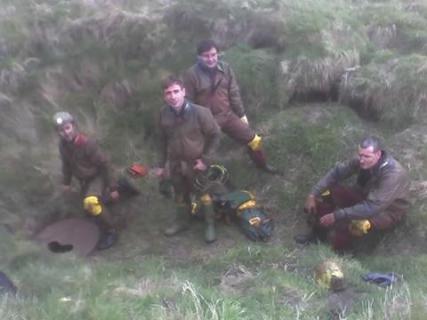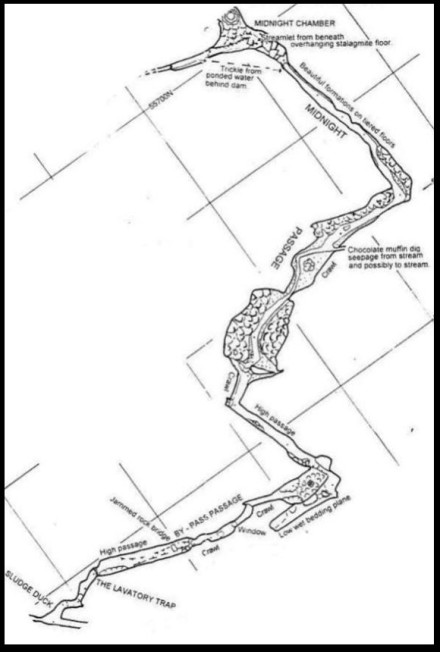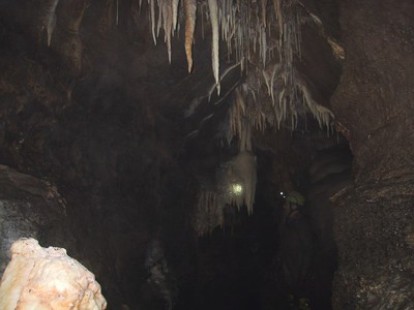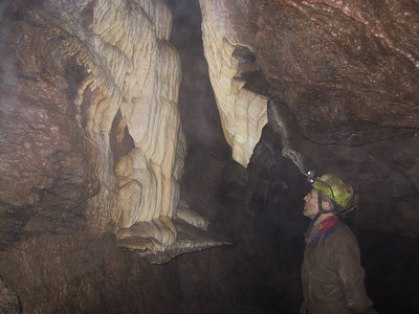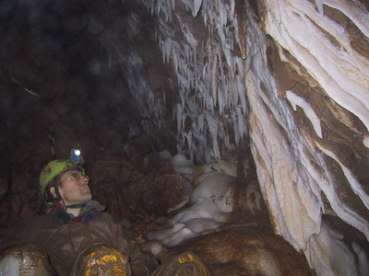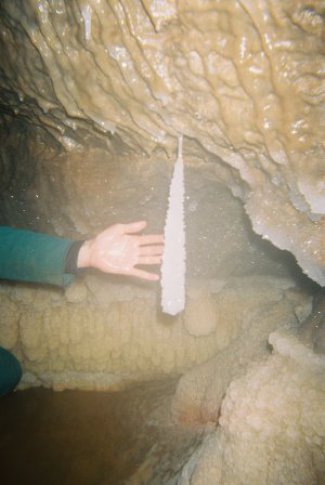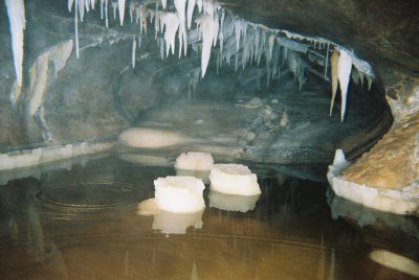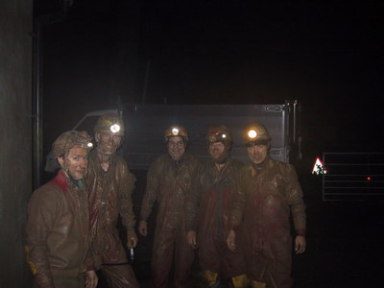Upper Flood
Surveys
Prepared by Ben Cooper
UF_2500_surface.pdf
Adobe Acrobat document [10.5 MB]
Upper Flood WARDEN information - How to become a Warden and expectations of a Warden
MCG Occasional Publication no 7 - Blackmoor Valley from the Logbook by Tim Francis
MCG Member's weekends are on the Saturday adjoining the first Friday of each month. There is a good chance that a trip can be arranged at short notice on such a Saturday, by calling the cottage on 01761 462797 shortly before 10:00 AM.
MCG leaders are:
Andrew Horeckyi, Bill Chadwick, Ben Cooper, Brian Snell, Peat Bennett, Tim Francis, Kev Speight, Mike Waterworth, Julie Hesketh, Mike Richardson, Graham Price, Ed Waters, Richard Carey, David Lossl, James Major, Mark Edwards and Daniel Matthews.
Guest leaders are:
Henry Dawson, Andrew Atkinson, Lee Hawkswell, Tarn Stroud, Simon Flower and Jude Vanderplank, Chris Binding,.
Consevation and restricted access
Upper Flood Swallet is an exceptionally well-decorated cave. Controls are in place to conserve the cave and to record trips made.
Access is managed by Mendip Caving Group at the request of the landowner. Party size is limited to three plus the MCG leader.
In the Old Cave, there are many overhead formations which can only be avoided by crawling in the stream.
In the New Cave great care must be used to avoid any unecessary muddy contacts with the cave formations.
A Guide To Upper Flood Swallet
The entrance is located at the northern end of Velvet Bottom, 400 yards east of the minor crossroads at Charterhouse and lies in a shallow depression amongst grassy spoil heaps from lead mining activity.
Entrance to Midnight Chamber
A padlocked steel lid (renewed in 2007) covers a 12ft climb down through concrete piping in the back-filled entrance depression.
From the foot of the pipe a short passage leads to the head of a 6ft climb down to man-made steps. A back-filled pasage behind the steps originally led back towards the surface and timber roof shoring was seen.
A short length of passage and second flight of man-made steps leads down to a T-junction with Upper Flood Passage. To the left, a small boulder chamber is entered after 40ft of low passage and a very narrow rift can be followed to the left past a small sump to reach a too-tight inlet.
To the the right at the T-Junction an initially roomy passage with "deads" stacked on either side soon diminishes to a sometimes damp hands-and-knees crawl to the small, decorated First Chamber. Mud banks on either side of the chamber have been taped off and should be avoided. At the lower end of First Chamber, Upper Flood Passage continues as a short crawl which enters a narrow rift running for 50ft to a brief enlargement where a passage ascends on the left to a choke (partially back-filled).
A 30ft damp crawl ahead continues to The Duck, now only a low and wet passage. Water seeping through the floor of The Duck is thought to reappear a short way downstream in Midnight Passage
Crawling upslope from The Duck over mud-covered stalagmite leads to an easy squeeze and opens dramatically into Midnight Chamber and the start of Midnight Passage.
Midnight Chamber to Sludge Duck
Flowstone banks slope down to Midnight Streamway which enters from the right. Upstream, the passage becomes too low after 50ft.
Downstream, Midnight Passage on continues through beautifully decorated passage where GREAT CARE is needed to avoid breaking the profusion of straw formations.
About 200ft downstream is Chocolate Muffin Dig where some of the water from Midnght Passage seeps way.
The main passage widens to form a chamber and the stream is followed beneath a large boulder to enter High Passage. A further 200ft of mostly hands-and-knees crawling reaches a narrow slot, and climb down to a bedding plane after 30ft. J
ust before the slot, a climb up on the right leads to By-Pass Passage, a roomy overhead passage leading to a dug crawl ending at a drop into a high level passage. A normally unpleasant muddy duck (The Lavatory Trap) is encountered next, which can sump in wet weather. The Lavatory Trap is followed by an up and down crawl and a tight squeeze, Sludge Duck.
Sludge Duck to the Boulder Choke
Beyond Sludge Duck is a T-junction. Upstream (right) from the T-junction is Shale Rift with a stream, Shale Streamway (an inlet from the Blackmoor Valley presumed to sink down-valley from the Upper Flood entrance). Continuing upstream, a tight squeeze in Shale Rift enters a narrow passage completely formed along a fault in the Lower Limestone Shale. The rift, passing The Black Aven on the right, leads into a large, low, muddy chamber. Rip-Off Aven leads upwards on the right at the top of which is a wet chimney. The top of the chimney is situated very close to the surface. A surface dig, Upper Flood 2, failed to connect to this chimney and was abondoned although the gated entrance can still be seen near the Velvet Bottom car park a short distance down valley from the Upper Flood entrance depression.
Downstream from the Sludge Duck T-junction the way on becomes a crawl along The Canal, enlarging at Puddle Lake where the Midnight Passage stream (Midnight Streamway) enters from the left. This passage has been pushed upstream back towards the slot seen before the climb up to By-Pass Passage but is too tight.
Continuing downstream from Puddle Lake the combined Midnight Streamway and Shale Streamway reaches the Red Room and a boulder choke. The stream sinks at the side of the Red Room.
Leaving the Red Room via a low crawl, the way on starts descending steeply after a few metres to Split Rock Dig, a short climb down to a very short section of streamway and a climb up to the left leads into Andrew's Grotto. At the back of the grotto, a route can be followed up and left which eventually returns to the Red Room.
Boulder Choke to Departure Lounge
The way on to Golden Chamber is ahead, through the boulder choke; this is the Aug 2004 breakthrough and the first of a total of 13 squeezes leading to the Departure Lounge. The first two constrictions lead to a climb up into a low crawl into Golden Chamber. Immediately to the left on entering the chamber is a shelf covered in crystals; the chamber also has plenty of straws overhead.
At the back-right, descend between boulders to a 3m climb down. This leads to a narrow 4m long rift which was passed in May 2006. The rift opens into a roomy passage "Streamway Regained" with a stream entering from a rift to the right. This has been followed upstream to a point very close to the stream last seen in Split Rock Dig. There a several extremely tight constrictions en route and the whole passage is extremely well decorated. As such it should not be entered. Opposite is a narrow rift. This starts off as being well decorated but soon degenerates into a low wet and claustrophobic tube. After 3 metres of desperate wriggling the tube pops out into a well decorated grotto. The end closes down at a boulder fall with a sound connection to the upstream passage
Downstream from Streamway Regained, the stream sinks to the right after a few metres, and the passage appears to end in a chamber (now mostly filled with spoil) 14m from the rift. This marks the start of the main boulder choke.
The Main Boulder Choke
The route through the boulder choke mainly follows the solid wall to the right. Go right through a hole into the "3D Squeeze" U-bend, and then climb up in the choke. Pass through a squeeze after a few metres, and climb up to a slumped boulder which is supported (Oct 2006) with an Acro Prop. Pass under the prop, then drop feet first into a slot against the right-hand wall. This is "Not Easy Squeeze"; there have been a number of rock falls at this point, and care should be taken. At the end of the slot drop through the hole onto a large perched boulder.
Climb about 5m down from the boulder, most easily by chimneying down the opposite side to the previous hole; a fixed handling is in place (Oct 2006). At the bottom double back and descend until a turn left leads to a squeeze between a flowstone block and the wall. Immediately after, drop through another squeeze into a rift between the wall and the boulders. This rift can be followed to a small triangular opening and a short descent to a point where a crawl under levitating boulders to the right leads to the "easySqueeze", the Sept 2006 breakthrough squeeze.
The breakthrough squeeze is down the slot at the back. Below the squeeze work down between the wall and the boulders for about 5 metres until it is possible to work to the right (with your back to the wall). After a few metres (and a total of 13 squeezes since leaving Andrews Grotto) a large black space comes into view; this is the main Blackmoor Master Cave passage. Immediately upslope from the point of entry is a steep climb to the higher reaches of the boulder choke (taped off). An ominous roof collapse appears to block the way on. But a tricky 4m climb up a flowstone wall on the left allows access to further sections of boulder choke. A wriggle between boulders pops out into a large void into the choke and a balcony. **Warning: extreme caution should be taken in this area**. Holes in the roof and floor between boulders can be seen but the lack of any solid walls has deterred further exploration.
The boulder choke gives way to a boulder slope into the largest section of passage, "Departure Lounge". The initial part of this is some 12 metres square; the left-hand wall is a continuous 5 metre high flowstone for around 30 metres. At the base of the "Departure Lounge", on a large slab, a rescue dump has been placed. This consists of three sealed Daren drums containing a comprehensive survival kit. These should not be opened except in an emergency. Immediately after the rescue dump a rocky taped off route leads to a stal window and flowstone climb back down to the streamway.
Blackmoor Master Cave
The next 500 metres or so comprise Malcolm's Way, and is mostly in large walking passage or high walking rift. The stream is met at the bottom of the boulder choke, and is followed for the entire length of the passage, with occasional stooping or crawling sections in water. The whole passage is well decorated. The initial part of this is some 12 metres square; the left-hand wall is a continuous 5 metre high flowstone for around 30 metres. There is extensive taping which should be strictly adhered to avoid damaging the formations, which include roof pendants, straws, flowstone, curtains and mud castles. All avens in the roof have been climbed but none lead to any significant amount of passage.
At the start is a small section of crawling and stooping at stream level. This ends at a wet wriggle under a boulder before walking passage is regained. Above and behind the boulder is a steep flowstone cascade over boulders (taped off ? no entry). This leads to a chamber, just out of view, which pinches out at the top.
The streamway continues on as a fine straight rift. A climb over boulders (left hand side) bypasses a wet duck at stream level. The next section, the "Zig Zags", is a fine piece of stream passage with sharp left and right bends. The first right bend is marked by a deep pool but the streamway soon becomes shallow again and dropping to a crawl under straws. A low crawl passes a small muddy inlet on the right. This flows continuously but the water just wells up out of a muddy wallow. The second right bend is marked by a large piece flowstone, the "Duck Under Boss". Above the boss (taped off - no entry) is a small grotto leading to a low crawl which terminates at a chest deep gour. There is no way on beyond.
At around 250 metres from the boulder choke the stream passage opens out at a large chamber, "Walk the Plank" where a large flowstone cascade comes in from the right. A fixed handline (June 2007) allows access to the upper levels of the slope. A steep climb - keep to the right hand wall - reaches the small "Walk the Plank Inlet" at the very top. This wet and muddy inlet has been pursued for 5m. A way can be seen but needs digging. Back across the chamber a large passage can be seen heading off downslope (taped off - no entry). This flyover runs for 60m but is blocked.
The way on is down a short climb, doubling back under to avoid an exposed traverse. Opposite the climb down is an awkward 5m climb up black flowstone cascade. At the top is a small section of highly decorated passage which soon closes down.
Beyond "Walk the Plank" the passage dimensions are of a smaller size with crawling or stooping over boulders. The passage opens out briefly where a flowstone cascade comes in on the left. Voids in the roof (taped off) connect with a flyover passage which is more easily accessed further downstream on the right (also taped off).
The next point of interest is a small rubble slope on the right hand side. In wet weather this emits a sizeable stream. Walking sized passage heads back upslope with some fine drip formations in mud. A low crawl pops out into bigger stuff but which soon terminates in a pretty chamber with dripping avens. Just back from the terminus is "Wall Street". 50m of drafting crawl ends in a dry gour (active dig Jun '07).
At around 400 metres, a climb on the right leads to "Charnel Inlet", and a rope climb to a mud filled passage. A desperate muddy squeeze has been dug to a mud blocakage. At the start "Charnel Inlet" in the floor on the left is a tight descending tube. A constriction after 8m has been passed to easier going beyond. This tight passage climbs quite steeply and the current end (June '07) is a tight flowstone rift. **Warning: poor air has been encountered here**.
The passage beyond Charnel Inlet is a photogenic high rift passage floored by boulders. The streamway is regained and a sharp right bend is marked by a fine flowstone cascade. //A small stream comes in from the left, ?Netherwood Inlet?. This has been pushed for 8m to an aqueous flowstone blockage//. Round the corner from "Netherwood Inlet" is a narrower section. A tight crawl leads to a slippy climb back down to the stream. Beyond this the passage is extremely constricted. The streamway can be followed along a narrow tube but in the roof is marginally easier. Both unite at a too tight squeeze with an unpromising pool just out of reach (dug May '07). This is the end of the Sept 2006 breakthrough.
Shortly before the climb down, it is possible to climb up some 4 metres on the left side of the passage into "Halogen Loft" and traverse to enter the Oct 2006 discoveries. A short muddy section leads to a steep climb over dryer mud to an opening into "Royal Icing Chamber", where several large blocks are capped with pure white calcite.
Continuing round to the left leads into "East Passage". This is radically different to the main passage, being in solid rock with no formations and a number of static pools. The route begins as a pleasant sized stroll before steepening in gradient at a loose rubble slope. Above a heavy drip falls out of "Zebra Aven" (unclimbed) and ahead is a small oxbow. The passage continues as a series of traverses leading to a crawl and pot. Hidden behind the choke on the right wall of the traverse is a tricky aven climb. At the top of the aven are two small phreatic tubes and pretty grotto. Beyond the pot a muddy tube in the right-hand wall can be followed into a muddy descending tube. This terminates in a brief section of walking sized passage and a large sump which has been dived to a blank wall. Bad air has been experienced throughout this section and warning signs are now in place (November 2006).
West Passage to the Far End
Back at "Royal Icing Junction", continue ahead and ascend the taped route over the flowstone. At the top of the ascent, pass a large cubic boulder to a well decorated descent. At the bottom, climbing down leads to a too tight constriction over a mud floor. Back on the left is a narrow rift guarded by a fine curtain (no entry). This soon becomes too tight. A bypass to the mud floor is offered by a small roof tube and tricky climb, just back and above the constriction. Beyond is another 50m+ of desending crawl passage over mud and pools. This has been know to back up in wet weather.
Back on the flowstone ascent above Royal Icing Junction, just after the cubic boulder and on the left is a high rift. This is blocked by a flowstone choke. Just before the cubic boulder, the main way on is through a taped gap between the right-hand wall and a boulder, to a descent through one of the best decorated parts of the cave, passing the fine grotto "NeverLand" to the left. At the bottom of the slope duck into the low arch on the left and follow the crawl over firm drier mud.
The crawl arrives at hole, at the bottom of which is what appears to be a perched sump, "Chuckle Sump". This has been bailed to a mud and rocks blockage but quickly refills after wet weather. A stream can be heard through the rocks just above the sump; this is "Chuckle Choke". Traversing past the hole leads into "West Passage", which continues in an almost straight line (with the exception of a single left-right joggle) for around 150 metres. The passage contains some nice gour dams, and some extremely liquid mud. At the end, the passage turns sharp left and terminates a few metres on, but a low arch to the right gives access to "West End Chamber".
The probable exit from "West End Chamber" is behind the boulder at the right-hand end, the muddy flat-out "95% Percent" crawl. This terminates in drafting boulder choke. A too tight squeeze between boulders blocks the way on and will need serious shoring before any further progress can be made. **This section is potentially dangerous and should be treated with extreme caution; collapses have already occurred**.
Neverland
"Neverland" contains the best formations in the currently known cave, perhaps some of the best in the UK. Now that a link to Neverland from West pasage has been opened, the original way in from the top of the descent to West Passage is no longer used.
The old route starts with flat out crawl for the first few metres to avoid the formations on the ceiling, and keeps to the right to avoid further formations. It then continues for about 20 metres past fine formations including cubic crystal encrusted carrots and fist-sized Pom Poms. At the end, a flat out rocky crawl, "Bare Hands Break-through", emerges part way up the large Pork Pie Passage.
The new bypass is accessed part way down "West Passage", as a climb up on the left. After a bit of vertical thrutching, cavers emerge above a pond in the main "Neverland" passage. Take care on descending to the pond to avoid dirtying the calcite tidemarks on the walls. At the pond, oversuits must be removed and boots and gloves scrubbed clean before turning left towards "Pork Pie Passage". To the right, an approach may be made close to "Funnel Chamber" to admire the "Curtain Climb". A second bypass is being sought that will join the passage west of "Curtain Climb". Until that is available, trips over "Curtain Climb" are being kept to an absolute minimum.
"Pork Pie Passage" initially starts as walking sized and is liberally decorated with formations. Side inlets close down immediately. After 20m the passage appears to close down at a low crawl. This contains gour dams and lakes with snow-white dinner-plate sized islands formed from large crystals rising several inches out of the water. Beyond the Pork Pies (taped off - no entry) the passage closes down at a flowstone blockage.
Downslope from "Bare Hands Break-through" there is a fine calcite slope covered in sharp crystals and a series of pools. The route passes numerous flowstone banks and ribbed curtains. An inlet to the left leads down to a crystal clear sump, "Neverland Sump". This has been dived with no conclusion (Jan '07) A small grotto is passed (Take care) until the passage is nearly blocked by a huge active flowstone bank and a solid curtain. It is possible to squirm between the flowstone and the ceiling, regaining large rift passage beyond.
After "Curtain Climb", a hole in the floor leads to a lower level but this soon closes down. The hole can be passed by means of a traverse and climb along the left hand side, a traverse line is in place. A straddle over another hole in the floor leads to a chimney. At the foot of the climb the large walking sized passage is regained. The passage meanders slightly with mud banks underfoot. A small passage down on the left leads to a low crawl. Straight ahead closes down at an unpromising puddle and to the right ends in a blind pit. Across the pit high up in the wall is the far end of the oxbow dig below the "Balcony Pitch". Soon after the low crawl is passed the main passage abruptly stops at an 8 metre pitch. A traverse around the top provides a bypass and easier climb down on the right; (handline in place, June '07).
Beyond The Pitch
Below the pitch passages appear complex but both the right hand and left hand passages unite after 20 metres. Immediately to the left from the pitch leads to a very low muddy crawl which has a connection with the "Blind Pit" (q.v.), and straight ahead enters a too tight rift. The way on to the further reaches is to the right from the pitch and through an uncomfortable muddy duck in the far right hand corner. This pops out into a fine section of walking passage. Around 50 metres of walking ends at an intimidating choke. Promising holes in the roof can be seen, and a sporting climb straight ahead enables access to a pair of large chambers above (Ladder and line in place, June '07). The roof of the first chamber has been climbed but further progress will require protection. The second chamber contains a fine flowstone cascade on the right hand wall. The rift high on the right hand side of the chamber can be climbed for 15m but it pinches out at the top.
The way on from the second chamber is over a jumble of rocks low and on the left. A very low muddy streamlet can be wriggled along for 10m but easier going is soon refound. A short section of walking passage opens out into the largest known chamber in the cave, a 20-25 metre high fault controlled chamber with huge jammed boulders in the roof. The stream appears to sink in a jumble of rocks and mud in the floor and the aven appears to be a very difficult climb.

